Nano-Restoration for Sustaining Soil Fertility: A Pictorial and Diagrammatic Review Article
- PMID: 36145792
- PMCID: PMC9504293
- DOI: 10.3390/plants11182392
Nano-Restoration for Sustaining Soil Fertility: A Pictorial and Diagrammatic Review Article
Abstract
Soil is a real treasure that humans cannot live without. Therefore, it is very important to sustain and conserve soils to guarantee food, fiber, fuel, and other human necessities. Healthy or high-quality soils that include adequate fertility, diverse ecosystems, and good physical properties are important to allow soil to produce healthy food in support of human health. When a soil suffers from degradation, the soil's productivity decreases. Soil restoration refers to the reversal of degradational processes. This study is a pictorial review on the nano-restoration of soil to return its fertility. Restoring soil fertility for zero hunger and restoration of degraded soils are also discussed. Sustainable production of nanoparticles using plants and microbes is part of the process of soil nano-restoration. The nexus of nanoparticle-plant-microbe (NPM) is a crucial issue for soil fertility. This nexus itself has several internal interactions or relationships, which control the bioavailability of nutrients, agrochemicals, or pollutants for cultivated plants. The NPM nexus is also controlled by many factors that are related to soil fertility and its restoration. This is the first photographic review on nano-restoration to return and sustain soil fertility. However, several additional open questions need to be answered and will be discussed in this work.
Keywords: degraded soil; polluted soil; salt-affected soil; soil conservation; soil degradation; soil–plant nexus; waterlogged soil.
Conflict of interest statement
The authors declare no conflict of interest.
Figures
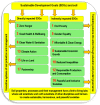
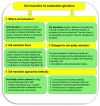

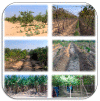
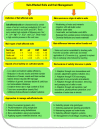



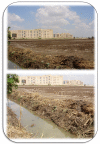
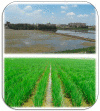
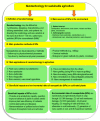





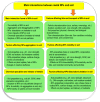



Similar articles
-
[Native plant resources to optimize the performances of forest rehabilitation in Mediterranean and tropical environment: some examples of nursing plant species that improve the soil mycorrhizal potential].C R Biol. 2013 May-Jun;336(5-6):265-72. doi: 10.1016/j.crvi.2013.04.015. Epub 2013 Jun 25. C R Biol. 2013. PMID: 23916201 French.
-
Promises and potential of in situ nano-phytoremediation strategy to mycorrhizo-remediate heavy metal contaminated soils using non-food bioenergy crops (Vetiver zizinoides & Cannabis sativa).Int J Phytoremediation. 2020;22(9):900-915. doi: 10.1080/15226514.2020.1774504. Epub 2020 Jun 13. Int J Phytoremediation. 2020. PMID: 32538143 Review.
-
Bacteria and fungi can contribute to nutrients bioavailability and aggregate formation in degraded soils.Microbiol Res. 2016 Feb;183:26-41. doi: 10.1016/j.micres.2015.11.007. Epub 2015 Nov 25. Microbiol Res. 2016. PMID: 26805616 Review.
-
Municipal solid waste (MSW): Strategies to improve salt affected soil sustainability: A review.Waste Manag. 2019 Feb 1;84:38-53. doi: 10.1016/j.wasman.2018.11.020. Epub 2018 Nov 19. Waste Manag. 2019. PMID: 30691912 Review.
-
Carbon Nanodot-Microbe-Plant Nexus in Agroecosystem and Antimicrobial Applications.Nanomaterials (Basel). 2024 Jul 25;14(15):1249. doi: 10.3390/nano14151249. Nanomaterials (Basel). 2024. PMID: 39120354 Free PMC article. Review.
Cited by
-
Biotechnological Applications of Mushrooms under the Water-Energy-Food Nexus: Crucial Aspects and Prospects from Farm to Pharmacy.Foods. 2023 Jul 11;12(14):2671. doi: 10.3390/foods12142671. Foods. 2023. PMID: 37509764 Free PMC article. Review.
-
Effects of the age of raised beds on the physicochemical characteristics of fruit orchard soil in the Vietnamese Mekong Delta.PeerJ. 2023 Sep 29;11:e16178. doi: 10.7717/peerj.16178. eCollection 2023. PeerJ. 2023. PMID: 37790612 Free PMC article.
-
Synergistic interactions of nanoparticles and plant growth promoting rhizobacteria enhancing soil-plant systems: a multigenerational perspective.Front Plant Sci. 2024 Apr 29;15:1376214. doi: 10.3389/fpls.2024.1376214. eCollection 2024. Front Plant Sci. 2024. PMID: 38742215 Free PMC article. Review.
References
-
- El-Ramady H., Hajdú P., Törős G., Badgar K., Llanaj X., Kiss A., Abdalla N., Omara A.E.-D., Elsakhawy T., Elbasiouny H., et al. Plant Nutrition for Human Health: A Pictorial Review on Plant Bioactive Compounds for Sustainable Agriculture. Sustainability. 2022;14:8329. doi: 10.3390/su14148329. - DOI
-
- Shayanthan A., Ordoñez P.A.C., Oresnik I.J. The Role of Synthetic Microbial Communities (SynCom) in Sustainable Agriculture. Front. Agron. 2022;4:896307. doi: 10.3389/fagro.2022.896307. - DOI
-
- Gonçalves R.G.D.M., dos Santos C.A., Breda F.A.D.F., Lima E.S.A., Carmo M.G.F.D., Souza C.D.C.B.D., Sobrinho N.M.B.D.A. Cadmium and lead transfer factors to kale plants (Brassica oleracea var. acephala) grown in mountain agroecosystem and its risk to human health. Environ. Monit. Assess. 2022;194:366. doi: 10.1007/s10661-022-10035-6. - DOI - PubMed
Publication types
Grants and funding
LinkOut - more resources
Full Text Sources

